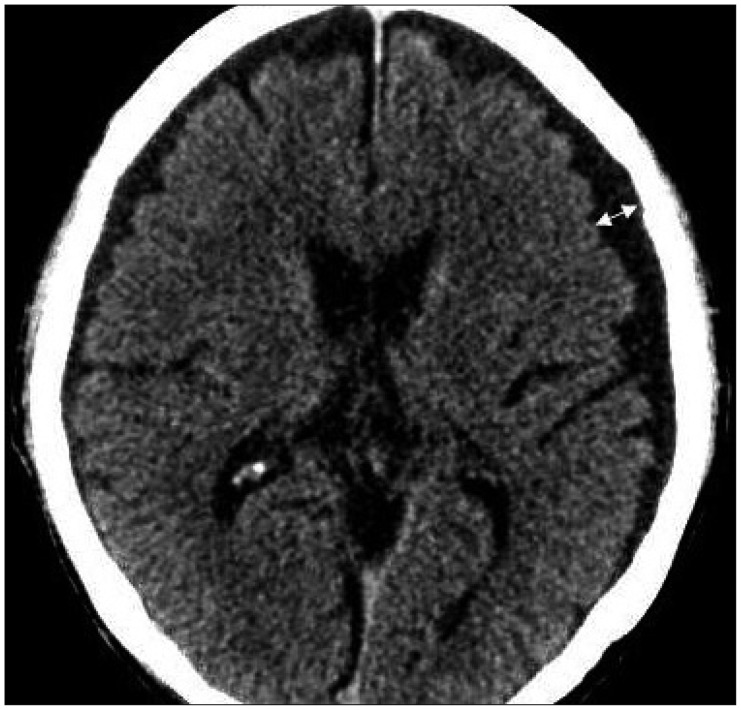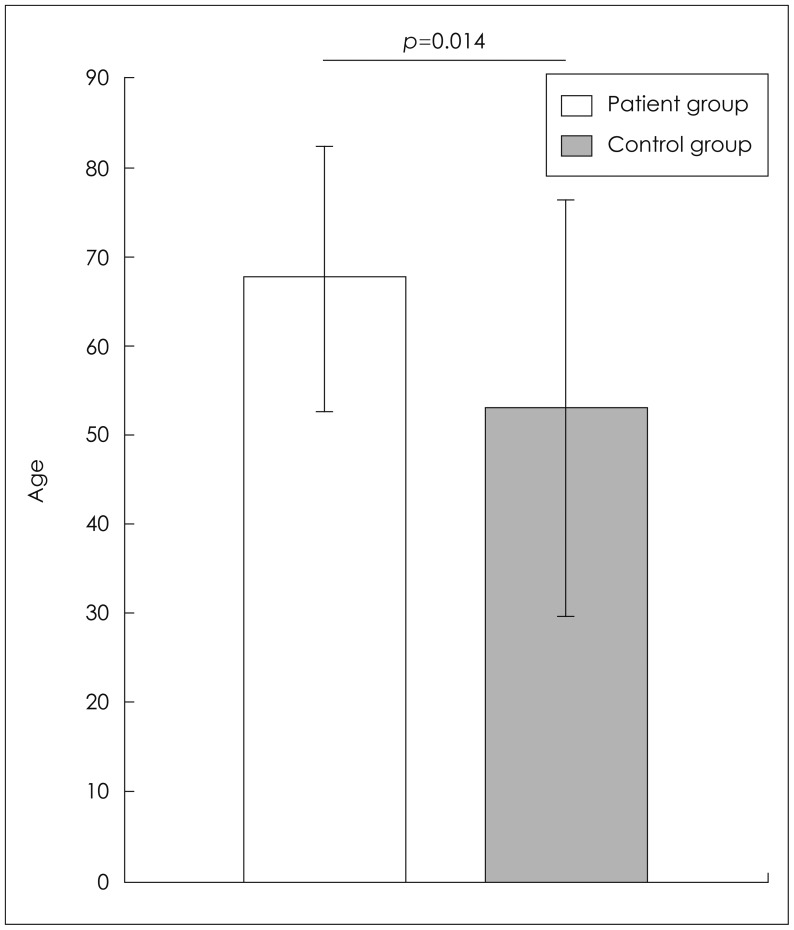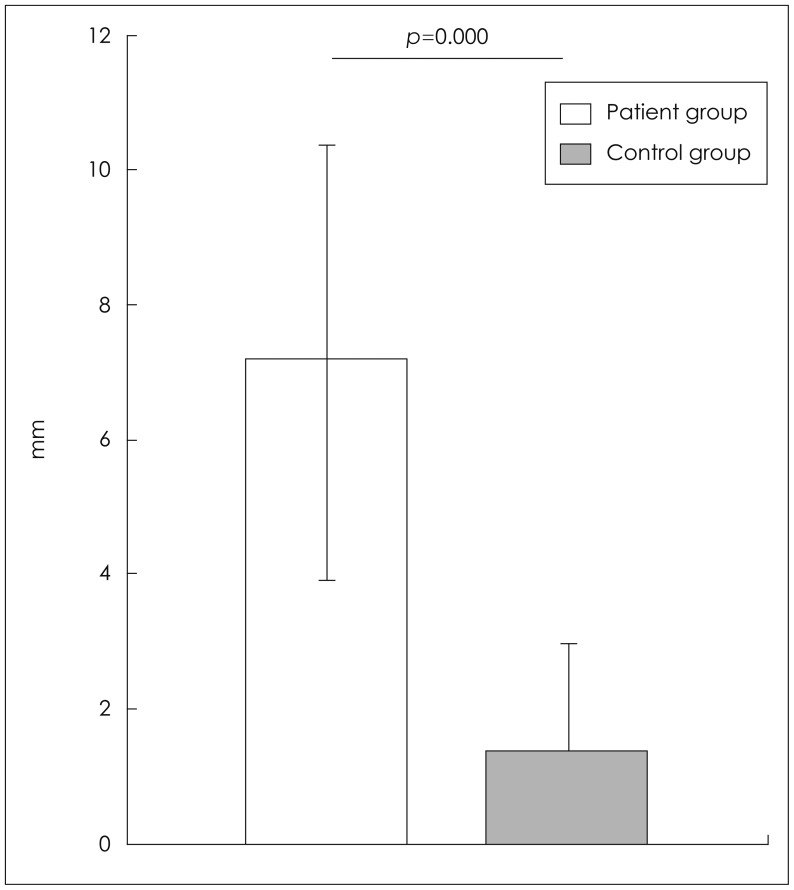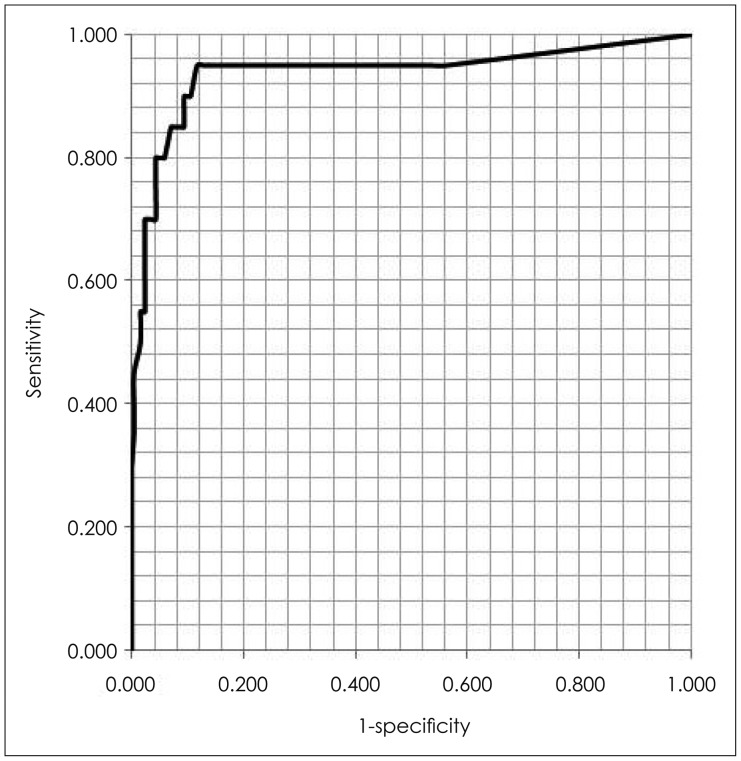Prediction of Chronic Subdural Hematoma in Minor Head Trauma Patients
- Affiliations
-
- 1Department of Neurosurgery, School of Medicine, Chungnam National University, Daejeon, Korea. swchoi@cnu.ac.kr
- KMID: 2256242
- DOI: http://doi.org/10.13004/kjnt.2014.10.2.106
Abstract
OBJECTIVE
Chronic subdural hematoma (CSDH) is relatively common in neurosurgical field. However not all patients develop CSDH after minor head trauma. In this study, we evaluate the risk factors of post-traumatic CSDH.
METHODS
Two-hundred and seventy-seven patients were enrolled and analyzed in this study from January 2012 to December 2013. Of those, 20 participants had minor head trauma developed CSDH afterward. We also included 257 patients with minor head trauma who did not develop CSDH during the same follow-up period as the control group. We investigated the risk factors related to the development of CSDH after minor head trauma.
RESULTS
Old age (p=0.014), preexisting diabetes mellitus (p=0.010), hypertension (p=0.026), history of cerebral infarction (p=0.035), antiplatelet agents (p=0.000), acute subdural hematoma in the convexity (p=0.000), encephalomalacia (p=0.029), and long distance between skull and brain parenchyma (p=0.000) were significantly correlated with the development of CSDH after trauma. Multivariate analysis revealed that only the maximum distance between the skull and the cerebral parenchyma was the independent risk factor for the occurrence of CSDH (hazard ratio 2.55, p=0.000).
CONCLUSION
We should consider the possibility of developing CSDH in the post-traumatic patients with the identified risk factors.
MeSH Terms
Figure
Cited by 4 articles
-
Middle Meningeal Artery Embolization in Recurrent Chronic Subdural Hematoma Combined with Arachnoid Cyst
Jiin Kang, Kum Whang, Soon-Ki Hong, Jin-Soo Pyen, Sung-min Cho, Jong-Yeon Kim, So-Hyun Kim, Ji-Woong Oh
Korean J Neurotrauma. 2015;11(2):187-190. doi: 10.13004/kjnt.2015.11.2.187.The Effectiveness of Subdural Drains Using Urokinase after Burr Hole Evacuation of Subacute Subdural Hematoma in Elderly Patients: A Prelimilary Report
Chang-Gi Yeo, Woo-Yeol Jeon, Seong-Ho Kim, Oh-Lyong Kim, Min-Su Kim
Korean J Neurotrauma. 2016;12(2):101-106. doi: 10.13004/kjnt.2016.12.2.101.Delayed Operation of Acute Subdural Hematoma in Subacute Stage by Trephine Drainage using Urokinase
Hyeon Gu Kang, Kyu Yong Cho, Rae Seop Lee, Jun Seob Lim
Korean J Neurotrauma. 2019;15(2):103-109. doi: 10.13004/kjnt.2019.15.e32.Risk Factors of Delayed Surgical Intervention after Conservatively Treated Acute Traumatic Subdural Hematoma
Hyungjoo Kwon, Kyu-Sun Choi, Hyeong-Joong Yi, Hyoung-Joon Chun, Young-Jun Lee, Dong-won Kim
J Korean Neurosurg Soc. 2017;60(6):723-729. doi: 10.3340/jkns.2017.0506.011.
Reference
-
1. Adhiyaman V, Asghar M, Ganeshram KN, Bhowmick BK. Chronic subdural haematoma in the elderly. Postgrad Med J. 2002; 78:71–75. PMID: 11807186.2. Asghar M, Adhiyaman V, Greenway MW, Bhowmick BK, Bates A. Chronic subdural haematoma in the elderly--a North Wales experience. J R Soc Med. 2002; 95:290–292. PMID: 12042376.
Article3. Berghauser Pont LM, Dammers R, Schouten JW, Lingsma HF, Dirven CM. Clinical factors associated with outcome in chronic subdural hematoma: a retrospective cohort study of patients on preoperative corticosteroid therapy. Neurosurgery. 2012; 70:873–880. discussion 880. PMID: 21937933.4. Chon KH, Lee JM, Koh EJ, Choi HY. Independent predictors for recurrence of chronic subdural hematoma. Acta Neurochir (Wien). 2012; 154:1541–1548. PMID: 22653496.
Article5. Jolobe OM. Chronic subdural haematoma in the elderly. J R Soc Med. 2002; 95:427–428. PMID: 12151502.
Article6. Jones S, Kafetz K. A prospective study of chronic subdural haematomas in elderly patients. Age Ageing. 1999; 28:519–521. PMID: 10604502.
Article7. Ko BS, Lee JK, Seo BR, Moon SJ, Kim JH, Kim SH. Clinical analysis of risk factors related to recurrent chronic subdural hematoma. J Korean Neurosurg Soc. 2008; 43:11–15. PMID: 19096538.
Article8. Laviv Y, Rappaport ZH. Risk factors for development of significant chronic subdural hematoma following conservative treatment of acute subdural hemorrhage. Br J Neurosurg. 2014; 1–6.
Article9. Lee KS, Bae WK, Doh JW, Bae HG, Yun IG. Origin of chronic subdural haematoma and relation to traumatic subdural lesions. Brain Inj. 1998; 12:901–910. PMID: 9839025.10. Lindvall P, Koskinen LO. Anticoagulants and antiplatelet agents and the risk of development and recurrence of chronic subdural haematomas. J Clin Neurosci. 2009; 16:1287–1290. PMID: 19564115.
Article11. Luxon LM, Harrison MJ. Chronic subdural haematoma. Q J Med. 1979; 48:43–53. PMID: 482590.12. Markwalder TM. Chronic subdural hematomas: a review. J Neurosurg. 1981; 54:637–645. PMID: 7014792.
Article13. Mori K, Adachi K, Cho K, Ishimaru S, Maeda M. Quantitative kinetic analysis of blood vessels in the outer membranes of chronic subdural hematomas. Neurol Med Chir (Tokyo). 1998; 38:697–702. discussion 702-703. PMID: 9919900.
Article14. Mori K, Mitsuoka H, Cho K, Tajima A, Maeda M. Rate constant of gadolinium (Gd)-DTPA transfer into chronic subdural hematomas. Neurol Res. 1996; 18:126–134. PMID: 9162866.
Article15. Ohno K, Suzuki R, Masaoka H, Matsushima Y, Inaba Y, Monma S. Chronic subdural haematoma preceded by persistent traumatic subdural fluid collection. J Neurol Neurosurg Psychiatry. 1987; 50:1694–1697. PMID: 3437306.
Article16. Okano A, Oya S, Fujisawa N, Tsuchiya T, Indo M, Nakamura T, et al. Analysis of risk factors for chronic subdural haematoma recurrence after burr hole surgery: optimal management of patients on antiplatelet therapy. Br J Neurosurg. 2014; 28:204–208. PMID: 23952136.
Article17. Reymond MA, Marbet G, Radü EW, Gratzl O. Aspirin as a risk factor for hemorrhage in patients with head injuries. Neurosurg Rev. 1992; 15:21–25. PMID: 1584433.
Article18. Sato S, Suzuki J. Ultrastructural observations of the capsule of chronic subdural hematoma in various clinical stages. J Neurosurg. 1975; 43:569–578. PMID: 1181389.
Article19. Teale EA, Iliffe S, Young JB. Subdural haematoma in the elderly. BMJ. 2014; 348:g1682. PMID: 24620354.
Article20. Torihashi K, Sadamasa N, Yoshida K, Narumi O, Chin M, Yamagata S. Independent predictors for recurrence of chronic subdural hematoma: a review of 343 consecutive surgical cases. Neurosurgery. 2008; 63:1125–1129. discussion 1129. PMID: 19008766.21. Yamada H, Nihei H, Watanabe T, Shibui S, Murata S. [Chronic subdural hematoma occurring consequently to the posttraumatic subdural hygroma--on the pathogenesis of the chronic subdural hematoma (author's transl)]. No To Shinkei. 1979; 31:115–121. PMID: 426938.22. Yamamoto H, Hirashima Y, Hamada H, Hayashi N, Origasa H, Endo S. Independent predictors of recurrence of chronic subdural hematoma: results of multivariate analysis performed using a logistic regression model. J Neurosurg. 2003; 98:1217–1221. PMID: 12816267.
Article23. Yoon JW, Park IS, Park H, Kang DH, Park KB, Lee CH, et al. A study of the progression from acute subdural hematoma to chronic stage requiring surgical treatment. Korean J Neurotrauma. 2013; 9:74–80.
Article
- Full Text Links
- Actions
-
Cited
- CITED
-
- Close
- Share
- Similar articles
-
- Chronic Subdural Hematoma Due to Cumulative Trauma to the Head
- Arachnoid Cyst with Spontaneous Intracystic Hemorrhage and Chronic Subdural Hematoma
- Chronic Subdural Hematoma Superimposed on Posttraumatic Subdural Hygroma: A Report of Three Cases
- Abusive Head Trauma in Infants and Children in Japan
- Intraoperative Development of Contralateral Subdural Hematoma during Evacuation of Acute Subdural Hematoma: Case Report





